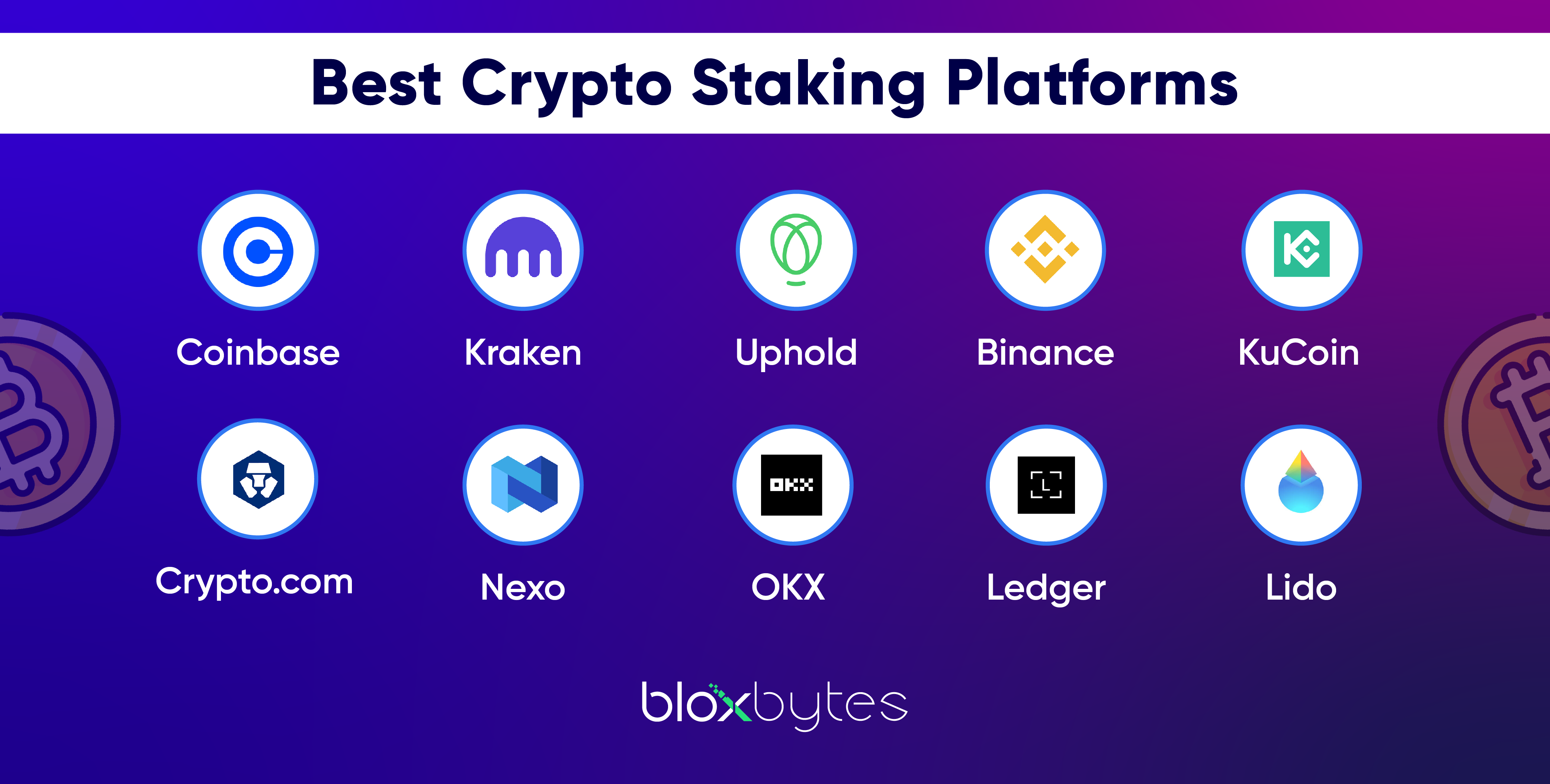
Introduction
Web3 & Blockchain Consultancy :
Your Guide to Choosing the Best Crypto Staking Platform in 2024
Cryptocurrency staking has rapidly gained popularity as a means for investors to earn passive income. In essence, staking involves holding cryptocurrencies in a digital wallet to support the operations of a blockchain network and receiving rewards in return. With the increasing number of crypto-staking platforms available, selecting the right one can be challenging. This blog is being created with the aim of providing you with the knowledge necessary to make an informed decision when choosing the best crypto-staking platform for your investment needs.What is Crypto Staking?
How Does Staking Work?
Staking is an essential process within blockchain networks, employing one of the Proof of Stake (PoS) consensus mechanisms. It enables users to actively contribute to the maintenance and security of a blockchain while earning rewards for their participation. Let’s dive into a comprehensive explanation of how staking operates:Understanding Proof of Stake (PoS)
Many blockchain networks utilize the PoS consensus mechanism, which forms the basis of staking, to achieve distributed consensus. Unlike Proof of Work (PoW), where miners solve complex mathematical puzzles to validate transactions and generate new blocks, PoS relies on users, often referred to as validators or stakers, locking up a portion of the network’s tokens as a stake. This stake acts as a security deposit and demonstrates the validator’s commitment to the network.The Staking Process
To support the network’s operations, users participate in a series of deliberate actions known as staking. They lock up a portion of their cryptocurrency holdings as a stake via a digital wallet or staking pool. By staking their tokens, users may become eligible to serve as validators. The criteria for selecting validators vary across blockchains; some networks randomly select validators from the staker pool, while others base their selection on the amount of stake. As validators, they validate transactions, create new blocks, and ensure adherence to the network’s rules. In return for their essential role in maintaining network security and integrity, validators receive rewards, typically in the form of additional tokens.The Role of Staking Pools
Staking pools have become increasingly popular, particularly since becoming a validator often requires a significant number of tokens, which may be inaccessible to individual investors. By pooling their stakes, users increase their chances of being selected as validators and receiving rewards. Subsequently, the rewards are distributed among pool members, typically based on each participant’s contribution.Risks and Considerations
While staking offers the potential for rewards, it also carries certain risks. The value of rewards is contingent on the market value of the cryptocurrency, which is subject to fluctuations. Additionally, there is the risk of slashing, wherein validators engage in malicious behavior or fail to fulfill their duties, resulting in a portion of their stake being forfeited. Moreover, staked tokens are often subject to lock-up periods during which they cannot be traded or sold.Participation in Governance
In addition to earning rewards, staking often grants participants a voice in the governance of the blockchain network. Depending on the size of their stake, stakeholders may have the opportunity to vote on important network decisions, such as protocol upgrades or modifications. Staking cryptocurrency offers significant benefits to participants in the blockchain ecosystem, particularly those engaged in Proof of Stake (PoS) consensus methods. These advantages extend beyond passive income generation and profoundly impact the operation and governance of blockchain networks. Here are the specific benefits of staking cryptocurrency:What Are The Benefits of Staking Crypto
Staking cryptocurrency offers significant benefits to participants in the blockchain ecosystem, particularly those engaged in Proof of Stake (PoS) consensus methods. These advantages extend beyond passive income generation and profoundly impact the operation and governance of blockchain networks. Here are the specific benefits of staking cryptocurrency:Generating Passive Income
The appeal of earning passive income through staking cryptocurrency cannot be overstated. Participants receive compensation for locking their cryptocurrency holdings, thereby contributing to the network’s operation. Often, these rewards are distributed in the form of staked cryptocurrency. This process operates within the domain of digital assets, akin to receiving dividends or interest from traditional financial investments. Staking can potentially yield higher returns compared to conventional savings accounts, especially in cryptocurrency markets with elevated interest rates. Importantly, these benefits stem from the network’s economic model, designed to promote sustained ownership and engagement, aligning stakeholder interests with the overall well-being and prosperity of the network.Contribution to Network Security
Staking plays a crucial role in enhancing the security and efficiency of blockchain networks. Validators are the key players in this process, facilitating transaction processing and block creation through Proof of Stake mechanisms. By ensuring continuous activity and security, validators mitigate the risk of fraudulent activities. To avoid fraud, validators are required to stake a specific quantity of cryptocurrency as a security deposit. Financial incentives within the system incentivize validators to act in the network’s best interests, bolstering defenses against cyber threats and ensuring reliable and seamless network operation.Energy Efficiency
Proof of Stake is popular for its energy efficiency, representing a significant advantage amidst mounting environmental concerns. Unlike proof-of-work mining, which consumes substantial electricity and specialized hardware, staking requires minimal energy consumption. This eco-friendly approach contributes to a reduction in the carbon footprint associated with blockchain activities. Moreover, the emphasis on sustainability inherent in Proof of Stake incentivizes broader participation, particularly among individuals deterred by the high energy costs and environmental impacts associated with traditional mining practices.Reduced Market Volatility
Staking means that you lock up a portion of the asset’s supply, thereby reducing its circulation and maintaining stability within cryptocurrency markets. By decreasing liquidity, staked assets exhibit greater resilience against the sharp price fluctuations typically induced by speculative trading activities. Consequently, the cryptocurrency market experiences diminished volatility. Furthermore, the requirement to hold tokens for a specified duration encourages a long-term investment perspective among stakeholders, bolstering market stability and mitigating the influence of transient speculative behaviors on asset valuation.The Risk Associated With Staking Crypto
Despite the numerous benefits of staking cryptocurrency, it comes with its share of risks that users should consider before getting involved. Let’s explore the main dangers associated with staking:Market Volatility
Staking doesn’t shield traders from the inherent volatility of cryptocurrency markets. If the price of the cryptocurrency experiences a sharp decline, participants may suffer losses. This is because the value of staked tokens is subject to change, and downturns can diminish the value of staking rewards, potentially resulting in a net loss if the decrease in token value outweighs the benefits of staking.Slashing
In Proof of Stake (PoS) networks, validators who engage in malicious activities or neglect their duties face penalties. Actions such as validating conflicting blocks or failing to promptly validate transactions can lead to slashing, wherein a portion of the validator’s stake is forfeited. While slashing serves to uphold network security, it poses a risk to validators’ funds, as even minor errors can incur fines.Network Security
While staking enhances the security of a blockchain network, it also introduces vulnerabilities. Centralization becomes a concern if a small number of validators control a significant portion of the staked tokens, potentially enabling coordinated attacks that compromise network security and facilitate abuse like censorship or double-spending. Additionally, decreased stake participation may make the network more susceptible to attacks by malicious actors seeking to exploit its weakened security posture.Technical Risks
Staking requires a certain level of technical proficiency and understanding of blockchain technology. Participants must ensure the security of their staking setup, including digital wallets and associated hardware or software, to prevent loss or theft of staked assets. Vulnerabilities in the staking infrastructure may be exploited by hackers to gain unauthorized access to funds. Moreover, participants need to stay informed about updates and changes to the staking protocol to avoid penalties or missed rewards resulting from non-compliance with maintenance schedules or network upgrades.Liquidity Constraints
Staking typically involves locking up tokens for a predetermined period, during which they cannot be freely traded. This lack of liquidity may pose challenges for participants needing access to their funds for unforeseen expenses or investment opportunities. While some staking protocols offer options to unstake or withdraw funds before the staking period ends, associated fees or delays may reduce liquidity. Participants should carefully evaluate their investment horizon and liquidity requirements before committing to staking.The Criteria for Choosing the Best Staking Platform
Choosing the right crypto staking platform is crucial for maximizing staking earnings and safeguarding staked assets. When evaluating staking platforms, consider the following criteria:Supported Cryptocurrencies
Seek staking platforms that offer support for a wide range of digital assets, including popular cryptocurrencies like Ethereum, Cardano, and Tezos. Diversification is key, allowing you to tailor your staking portfolio to your preferences and risk tolerance. Look for platforms that continuously add support for new projects and adapt to market trends, enhancing diversification opportunities and the potential for profit from changes in rewards and markets.Staking Benefits
Examine the factors influencing reward distribution beyond basic measures like ROI or APY. Look for platforms that provide detailed information on their reward systems, including validator performance metrics and the process for reward distribution. Consider platforms offering additional incentives or bonuses, and analyze past data on staking rewards to assess their consistency and reliability over time. Prioritize platforms that ensure fairness and transparency in reward allocation.Staking Conditions
Evaluate the staking conditions offered by platforms, as they significantly impact your staking experience and potential returns. Look for platforms that offer customizable staking strategies to align with your unique requirements and preferences. Consider factors such as staking lengths, minimum stake sizes, and the platform’s fee structure, including transaction fees, withdrawal fees, and validator commission rates. Assess how these factors may affect your overall returns.Security Measures
Given the risks associated with staking, prioritize platform security to protect your staked funds. Thoroughly review the platform’s security measures, including encryption methods, storage options, and measures to mitigate risks such as phishing or hacking attempts. Choose platforms that adhere to regulatory standards, conduct regular security assessments, and implement industry best practices in cybersecurity. Additionally, consider platforms that offer funding for security mechanisms or insurance coverage to mitigate the impact of potential security breaches.Best Crypto Staking Platforms
In this section, we will discuss the core segment of our blog, exploring in detail the best crypto staking platforms: